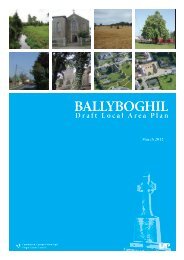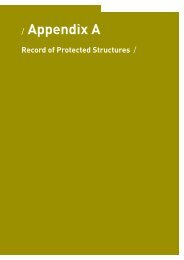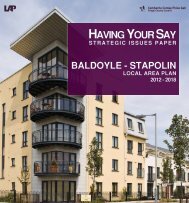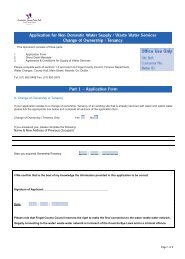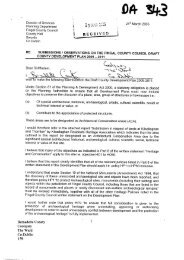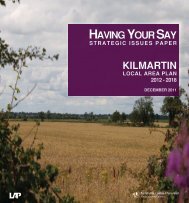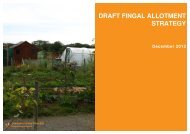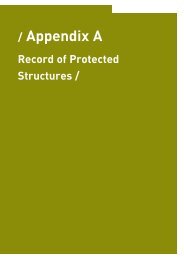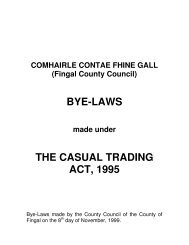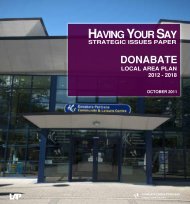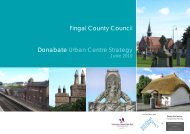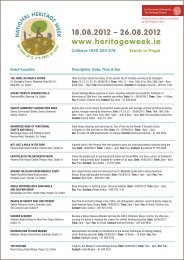Swords Masterplan - Fingal County Council
Swords Masterplan - Fingal County Council
Swords Masterplan - Fingal County Council
Create successful ePaper yourself
Turn your PDF publications into a flip-book with our unique Google optimized e-Paper software.
area. The development of the parks will require a site-specific Landscape<br />
Strategy and associated Appropriate Assessment. This shall be completed within<br />
12-24 months of the preparation of this <strong>Masterplan</strong>.<br />
While the treatment the public realm of the major urban spaces is discussed in<br />
detail elsewhere in this document, this section of the <strong>Masterplan</strong> highlights key<br />
issues of the public realm strategy for the Town Centre as a whole and consists of:<br />
● Streetscape (the ‘streetscape’ includes facades addressing the public areas<br />
as well as the highway, cycle lane, pavements and associated street furniture<br />
and planting).<br />
● Street furniture<br />
● Signage<br />
● Lighting<br />
● Public Art<br />
The following are key public realm criteria to be considered in relation to<br />
<strong>Swords</strong> Town Centre:<br />
1. The design and layout of buildings must incorporate the principles of<br />
passive surveillance to encourage a community atmosphere while<br />
discouraging anti-social behaviour.<br />
2. Active frontages are to be provided around the main public spaces,<br />
especially those of the major activity nodes.<br />
3. Pavements and walkways must be wide enough to accommodate<br />
wheelchairs and pushchairs and have dropped/sloping kerbs to<br />
ensure safe and easy crossing points.<br />
4. All crossing points should be located on pedestrian and cyclist<br />
desire lines.<br />
5. Guard rails and other street furniture should be kept to a minimum<br />
consistent with maintaining safety standards while avoiding visual clutter.<br />
6. Cycle paths should be clearly defined but changes of colour within<br />
the highway should be minimised.<br />
7. Paving materials should reflect the character of the area, whether it be<br />
the historic core of the civic quarter or the modern retail of Pavilions.<br />
8. The use of an agreed palette of materials will define the hierarchy of<br />
streets and spaces in the Town Centre, enhance the setting of civic<br />
buildings and identify pedestrian priority areas whilst reinforcing<br />
local distinctiveness.<br />
9. Signage and public art will be incorporated into the paving to add<br />
additional visual interest and minimize clutter within the streetscape.<br />
Detailing of railings and street furniture, such as planters, can also<br />
function as elements of public art within the streetscape.<br />
9.3 Street Furniture<br />
Street furniture should help to create a distinctive and consistent identity for the<br />
Town Centre whilst enabling individual character areas to be recognized. The coordination<br />
of street furniture, public art and streetscape can reduce visual clutter<br />
and create a ‘coherent’ Town Centre.<br />
1. The use of local and environmentally friendly materials can assist in<br />
minimising the visual intrusion of street furniture in the streetscene.<br />
2. The design and positioning of street furniture should also be co-ordinated to<br />
minimize clutter. Street furniture should be placed to avoid conflict with<br />
pedestrian movement. It should not reduce the width of the pavement to such a<br />
degree that it impacts on accessibility for users of wheelchairs and pushchairs.<br />
3. Trees will be used to soften the landscape in key locations, for example on the<br />
Metro Plaza they may be used to provide acoustic and visual barrier to the R132.<br />
4. Coordinating street furniture with planting will assist in creating attractive<br />
environments for pedestrians and in minimising visual intrusion.<br />
5. The positioning of seating and other street furniture will take account of the<br />
micro-climate. Ensuring protection from the wind and maximising sunlight<br />
will enhance use of spaces whilst also assisting with maintenance of street<br />
furniture.<br />
9.4 Signage<br />
Signage will be designed to convey directional and orientation information<br />
(particularly for visitors). Signage should be consistent and co-ordinated across<br />
the Town Centre. A Town Centre ‘identity’ can be achieved by consideration of:<br />
● Typeface;<br />
● Colour and materials used;<br />
● Shape, proportions and even heights of signs;<br />
● Use of logos.<br />
1. Some signage will be integrated with the design of buildings, and reflect the<br />
character of the area. Illumination of signage should be controlled,<br />
particularly in historic parts of the Town Centre.<br />
2. Where possible, signage should also be co-ordinated with street furniture<br />
and with information boards.<br />
3. High quality information boards/orientation signage will be provided at<br />
priority orientation points such as the Metro Quarter.<br />
1 0 1<br />
9.5 Lighting<br />
Lighting is a fundamental element of any strategy for the public realm. The<br />
design of the public realm must be able to support activity in the evening as well<br />
as during the day. Streets and spaces must encourage activity and provide safe<br />
and welcoming environments.<br />
On a practical level, lighting can improve the attractiveness of an area and make<br />
it feel safe for pedestrians at night. Lighting can also create interesting<br />
environments by illuminating buildings or key routes and enhancing the setting of<br />
civic buildings and spaces.<br />
1. Lighting needs to be sensitively designed and positioned to avoid clutter and<br />
light pollution. Lighting fixtures, fittings and columns should, wherever<br />
practicable, be incorporated into existing or proposed columns, street<br />
furniture and features to reduce the impact of lighting in the streetscape.<br />
2. The approach to lighting, particularly of important buildings, should be coordinated<br />
across the Town. The distinctive character of individual areas can<br />
however be emphasised by subtle changes in the lighting strategies, and<br />
coloured lighting can add a further dimension to this strategy. Low level<br />
lighting is likely to be required, and energy efficient lighting should be<br />
integrated into the strategy across the Town.<br />
3. Lighting strategies for special (whether civic or seasonal) events should be<br />
considered and the infrastructure incorporated into the design of new spaces<br />
and buildings.




